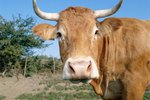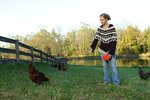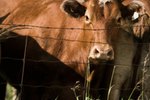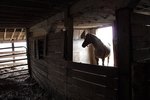
Cattle are not known for being gentle or careful with their hay. A herd of cows can waste hundreds of dollars worth of hay in a year due to dropping and then stepping on it. A hay feeder, even a homemade one, can be an effective means of saving time and money.
Hay Waste
If you do not already use a hay feeder, your cows are probably wasting a fairly significant percentage of the hay you put out for them to eat. The University of Missouri estimates that 50 percent of hay is ruined by ineffective feeding and/or poor storage methods. At such a rate of loss, if you spend $200 a month on hay, $100 of that hay is wasted rather than consumed. Hay waste is an expensive problem that can quickly add up to hundreds in losses for a even small cattle operations.
Hay Feeders
It is essential to make sure your cows are actually eating the hay you put out for them, and a hay feeder can help you do that. Hay feeders vary in design, but all of them have the same basic purpose. Hay feeders are strong structures that keep hay contained inside them while allowing the cows access to the hay through relatively small openings. The small openings prevent cows from pulling more hay out of the feeder than they can consume in a single bite, minimizing waste. The walls or sides of the feeder keep the hay in the feeder between bites, and off the ground, where it will go to waste.
Rings
Hay rings are simple and traditional hay feeders. Hay rings are most commonly made of metal, but some people construct similar structures using wood or fencing materials. Hay rings are designed so a round roll of hay fits inside; it keeps the hay contained so cows can not trample on it or soil it. Hay rings do not protect the hay from touching the ground. V-shaped ridges around the top of the hay ring limit the amount of hay the cows can pull out at one time and prevent large sections of the hay roll from being pulled out of the ring. Not all hay rings are circular; a homemade wooden box large enough to fit a single hay roll inside will perform the same job. Hay rings are typically chest-high on cattle and solidly built. Hay rings should be stationary; it should take significant effort to move one.
Off the Ground
Off-the-ground hay feeders can be stationary or built on top of a chassis for portability. These feeders hold the hay up; they typically have flat bottoms for the hay to sit on, well above ground-level. The sides and rails of one of these feeders keep the hay contained while providing openings through which cows can pull mouthfuls of hay out of the feeder. These feeders sit level with cows' chests or heads. They are designed so cows can access the hay through only the sides, not through the top. The benefit of the portable hay feeder is that you can move it whenever you feel the need.
References
Photo Credits
-
Thinkstock Images/Comstock/Getty Images
Writer Bio
Jen Davis has been writing since 2004. She has served as a newspaper reporter and her freelance articles have appeared in magazines such as "Horses Incorporated," "The Paisley Pony" and "Alabama Living." Davis earned her Bachelor of Arts in communication with a concentration in journalism from Berry College in Rome, Ga.




